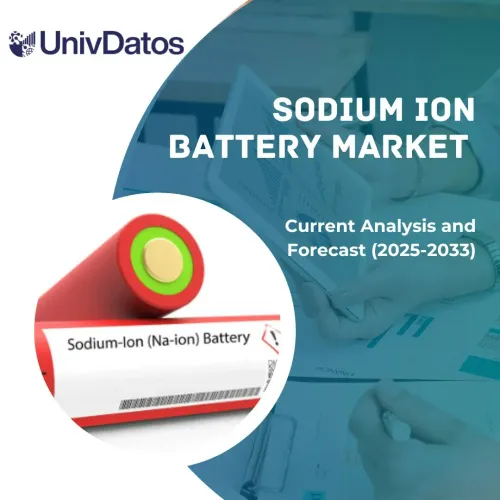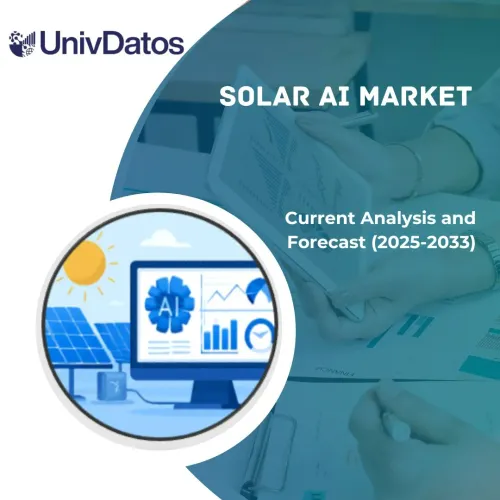Цифровая трансформация на энергетическом рынке: текущий анализ и прогноз (2024-2032)
Акцент на продуктах (аналитика больших данных, искусственный интеллект, системы промышленного управления, полевые устройства, расширенная реальность и IoT); применение (нефть и газ, выработка электроэнергии, коммунальные услуги и прочее); и регион/страна
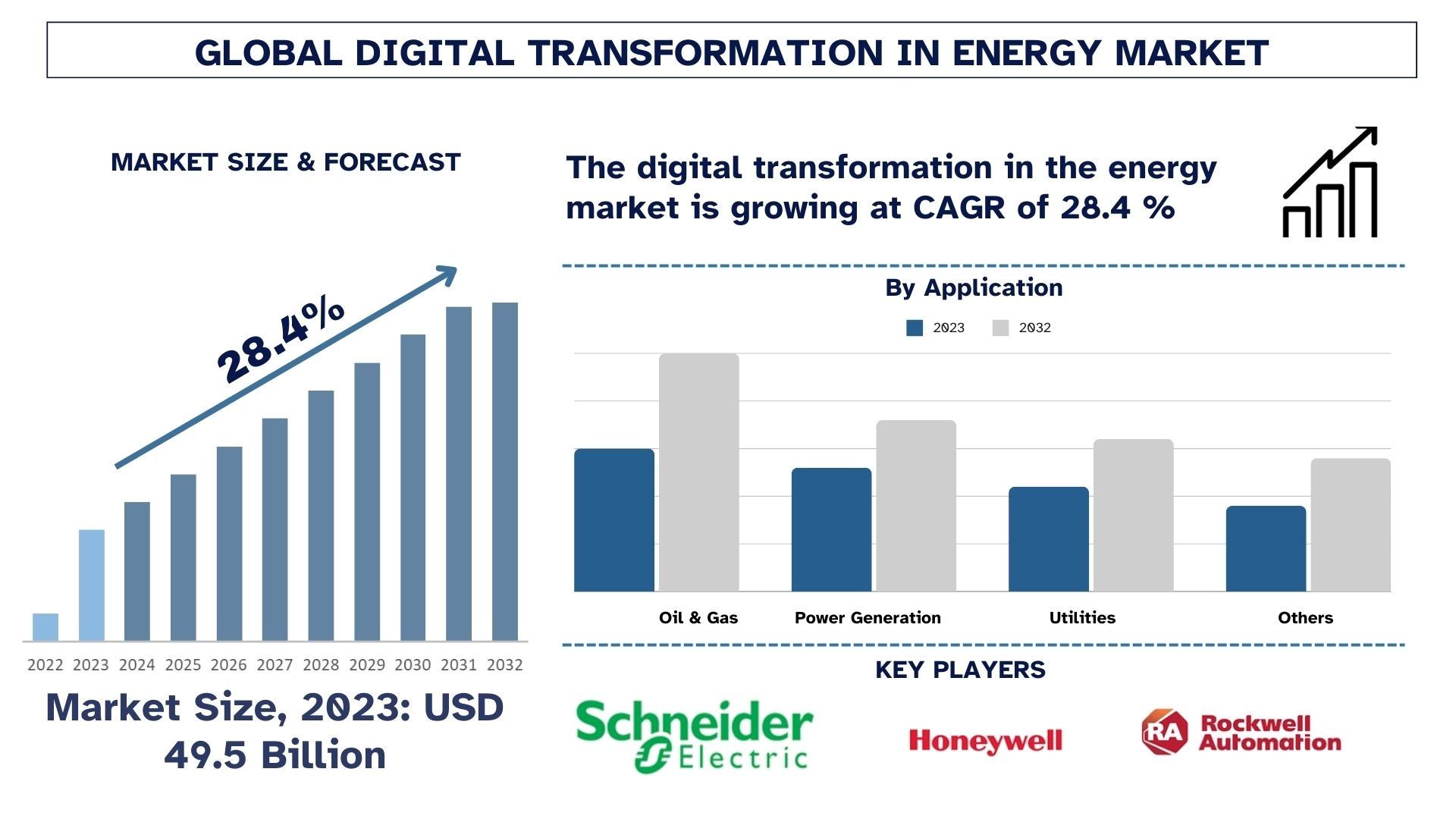
Размер и прогноз рынка цифровой трансформации в энергетике
Объем рынка цифровой трансформации в энергетике в 2023 году оценивался примерно в 49,5 миллиардов долларов США и, как ожидается, будет расти со среднегодовым темпом роста (CAGR) около 28,4% в течение прогнозируемого периода (2024-2032) из-за необходимости повышения операционной эффективности, интеграции возобновляемых источников энергии, повышения надежности сети и спроса на устойчивые и управляемые данными энергетические решения.
Анализ рынка цифровой трансформации в энергетике
Цифровая деятельность коренным образом меняет энергетическую отрасль, изменяя бизнес-модели и влияние организаций, а также предоставляя услуги клиентам. Это охватывает широкий спектр от интеллектуальных сетей и возобновляемых источников энергии до точного прогнозирования времени отказа оборудования на производственной линии завода. Вероятно, будут развернуты интеллектуальные сети для управления распределением электроэнергии, обнаружения сбоев в электроснабжении и адаптации к системным сбоям для эффективного энергопотребления. Современные формы возобновляемой энергии, такие как ветровая и солнечная, в настоящее время используются и улучшаются за счет цифровых интерфейсов для управления размещением и отслеживания производительности. Хранение энергии также улучшается и укрепляется с использованием цифровых технологий. Прогнозируемое техническое обслуживание применяется для сокращения затрат и предотвращения неисправностей оборудования путем составления графиков возможного выхода из строя оборудования.
Кроме того, цифровизация является возможностью гибкости для организации, где организация может добиться повышения энергоэффективности пользователей, фотоэлектрической зарядки и хранения, прогнозирования спроса и предложения и других операций..
Тенденции рынка цифровой трансформации в энергетике
В этом разделе обсуждаются ключевые рыночные тенденции, влияющие на сегменты рынка цифровой трансформации в энергетике, как это определено нашими экспертами по исследованиям.
Нефтегазовая отрасль преобразуется
Сегмент нефти и газа занимает значительную долю рынка в 2023 году в связи с высокой зависимостью от ископаемого топлива наряду с растущим спросом на энергию во всем мире. Цифровая трансформация также стимулирует инновации в нефтегазовой отрасли, приводя к разработке новых технологий и бизнес-моделей. Например, появляются цифровые торговые площадки, где производители и потребители могут прозрачно и безопасно торговать сырой нефтью, нефтепродуктами и природным газом. Кроме того, отрасль активно инвестирует в технологии возобновляемой энергии, такие как ветряная, солнечная и водородная, которые, как ожидается, будут играть важную роль в энергетическом балансе в будущем.
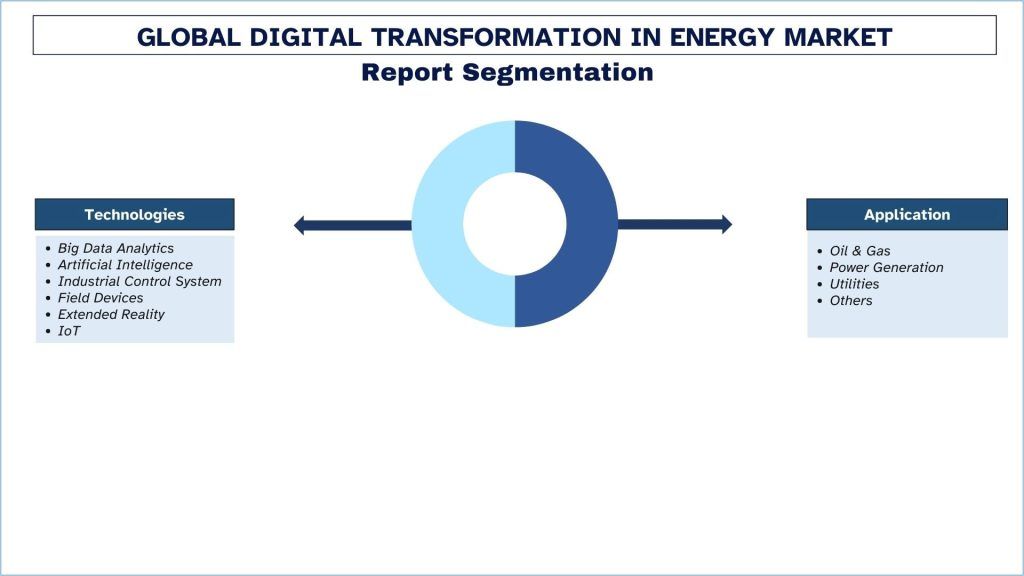
Ожидается, что Северная Америка будет расти со значительным среднегодовым темпом роста (CAGR) в течение прогнозируемого периода
Ожидается, что Северная Америка будет расти со значительным среднегодовым темпом роста (CAGR) в течение прогнозируемого периода из-за роста разведки месторождений сланцевой нефти и газа в сочетании с ростом технологических достижений, таких как гидравлический разрыв пласта, горизонтальное бурение и подводная разведка. Кроме того, важно отметить, что североамериканский энергетический рынок сейчас находится в середине цифрового перехода благодаря технологиям интеллектуальных сетей, возобновляемой энергии, хранению энергии и электромобилям. Внедрение цифровых технологий в систему энергосистемы позволяет коммунальным предприятиям эффективно генерировать и распределять электроэнергию с меньшими потерями и повышать надежность сети. В заключение следует отметить, что на североамериканский энергетический рынок влияет рост цифровых технологий, и возможности для развития выгодны обеим сторонам.
Обзор рынка цифровой трансформации в энергетике
Рынок цифровой трансформации в энергетике является конкурентным, с несколькими глобальными и международными игроками рынка. Ключевые игроки используют различные стратегии роста для расширения своего присутствия на рынке, такие как партнерства, соглашения, сотрудничество, запуск новых продуктов, географическая экспансия и слияния и поглощения. Некоторые из основных игроков, работающих на рынке: Schneider Electric SE, Honeywell International Inc., Rockwell Automation Inc., SAP, ABB, IBM Corporation, Microsoft, Cisco Systems Inc., Teradata и Intel Corporation.
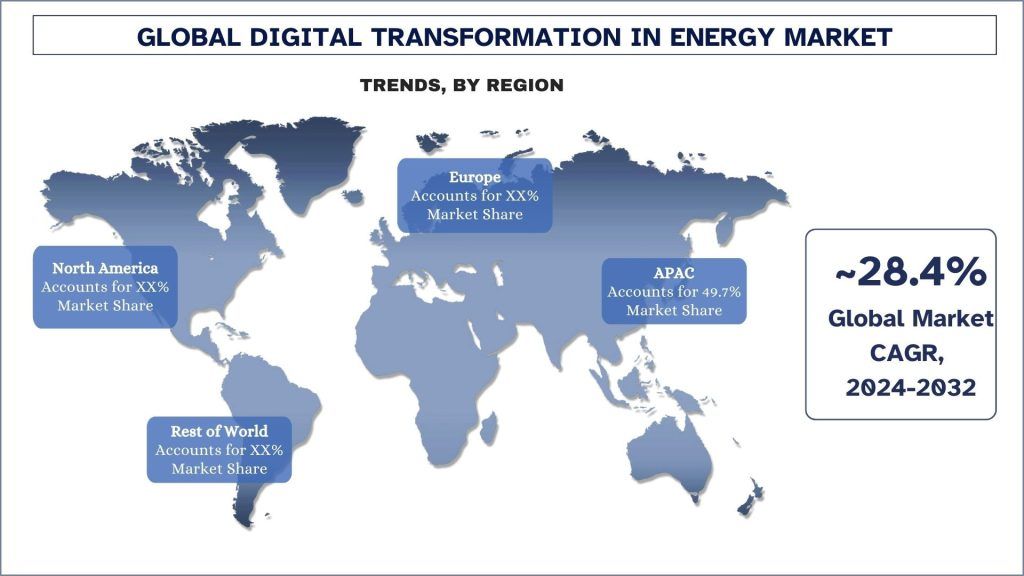
Новости рынка цифровой трансформации в энергетике
В январе 2023 года Федеральный кабинет Германии принял законопроект о перезапуске цифровизации энергетического перехода, устанавливающий дорожную карту развертывания интеллектуальных счетчиков и расширяющий сферу применения динамических тарифов
В мае 2023 года дочерняя компания испанской TSO Red Eléctrica (Redeia) Elewit объявила о своем проекте ASUMO, который направлен на улучшение сбора данных на электрических подстанциях с использованием ИИ и технологий цифровых двойников. Elewit, технологическая платформа для оператора передачи электроэнергии страны, объявила о проекте в ответ на необходимость автоматизированной эффективности в жизненном цикле сетевых активов.
Охват отчета по цифровой трансформации в энергетике
Детали | |
Базовый год | 2023 |
Прогнозный период | 2024-2032 |
Динамика роста | Ускорение со среднегодовым темпом роста (CAGR) 28,4 % |
Размер рынка 2023 | ~49,5 млрд долларов США |
Региональный анализ | Северная Америка, Европа, Азиатско-Тихоокеанский регион, Остальной мир |
Основной способствующий регион | Ожидается, что Азиатско-Тихоокеанский регион будет расти с самым высоким среднегодовым темпом роста (CAGR) в течение прогнозируемого периода. |
Основные охватываемые страны | США, Канада, Германия, Франция, Великобритания, Испания, Италия, Китай, Япония и Индия |
Schneider Electric SE, Honeywell International Inc., Rockwell Automation Inc., SAP, ABB, IBM Corporation, Microsoft, Cisco Systems Inc., Teradata и Intel Corporation. | |
Объем отчета | Тенденции рынка, факторы роста и ограничения; Оценка и прогноз выручки; Анализ сегментации; Анализ спроса и предложения; Конкурентная среда; Профилирование компаний |
Охваченные сегменты | По технологиям, по применению, по региону/стране |
Причины для покупки этого отчета:
- Исследование включает в себя анализ размеров рынка и прогнозирование, подтвержденные сертифицированными ключевыми экспертами отрасли.
- Отчет представляет собой краткий обзор общей производительности отрасли с первого взгляда.
- Отчет содержит углубленный анализ выдающихся отраслевых коллег с основным упором на ключевые финансовые показатели бизнеса, портфели продуктов, стратегии расширения и последние события.
- Детальное изучение факторов роста, ограничений, ключевых тенденций и возможностей, преобладающих в отрасли.
- Исследование всесторонне охватывает рынок по различным сегментам.
- Углубленный анализ отрасли на региональном уровне.
Опции кастомизации:
Глобальная цифровая трансформация на энергетическом рынке может быть дополнительно настроена в соответствии с требованиями или любым другим сегментом рынка. Кроме того, UMI понимает, что у вас могут быть свои собственные бизнес-потребности; поэтому, не стесняйтесь обращаться к нам, чтобы получить отчет, который полностью соответствует вашим требованиям.
Содержание
Методология исследования для анализа рынка цифровой трансформации в энергетике (2024-2032)
Анализ исторического рынка, оценка текущего рынка и прогнозирование будущего рынка мировой цифровой трансформации в энергетике были тремя основными этапами, предпринятыми для создания и анализа внедрения цифровой трансформации в энергетике в основных регионах мира. Был проведен исчерпывающий вторичный анализ для сбора исторических рыночных показателей и оценки текущего размера рынка. Во-вторых, были приняты во внимание многочисленные выводы и предположения для подтверждения этих данных. Кроме того, были проведены исчерпывающие первичные интервью с отраслевыми экспертами по всей цепочке создания стоимости глобального рынка цифровой трансформации в энергетике. После предположения и подтверждения рыночных показателей посредством первичных интервью, мы применили подход сверху вниз/снизу вверх для прогнозирования общего размера рынка. После этого были приняты методы разбивки рынка и триангуляции данных для оценки и анализа размера рынка сегментов и подсегментов отрасли. Подробная методология объясняется ниже:
Анализ исторического размера рынка
Шаг 1: Углубленное изучение вторичных источников:
Было проведено детальное вторичное исследование для получения исторических размеров рынка цифровой трансформации в энергетике из внутренних источников компании, таких какгодовые отчеты и финансовая отчетность, презентации о результатах деятельности, пресс-релизы и т. д.,и внешних источников, включаяжурналы, новости и статьи, правительственные публикации, публикации конкурентов, отраслевые отчеты, сторонние базы данных и другие авторитетные публикации.
Шаг 2: Сегментация рынка:
После получения исторических размеров рынка цифровой трансформации в энергетике мы провели детальный вторичный анализ для сбора исторических данных о рынке и долей для различных сегментов и подсегментов для основных регионов. В отчет включены основные сегменты, такие как технологии, приложения и регионы. Далее был проведен анализ на уровне стран для оценки общего внедрения моделей тестирования в этом регионе.
Шаг 3: Факторный анализ:
После получения исторических размеров рынка различных сегментов и подсегментов мы провели детальныйфакторный анализдля оценки текущего размера рынка цифровой трансформации в энергетике. Далее мы провели факторный анализ с использованием зависимых и независимых переменных, таких как технологии, приложения и регионы рынка цифровой трансформации в энергетике. Был проведен тщательный анализ сценариев спроса и предложения с учетом ведущих партнерств, слияний и поглощений, расширения бизнеса и запусков продуктов в секторе цифровой трансформации в энергетике по всему миру.
Оценка и прогноз текущего размера рынка
Определение текущего размера рынка:Основываясь на практических выводах из трех вышеуказанных шагов, мы пришли к текущему размеру рынка, ключевым игрокам на мировом рынке цифровой трансформации в энергетике и долям рынка сегментов. Все требуемые доли в процентах и разбивки рынка были определены с использованием вышеупомянутого вторичного подхода и были проверены посредством первичных интервью.
Оценка и прогнозирование:Для оценки и прогнозирования рынка различным факторам были присвоены веса, включая драйверы и тенденции, ограничения и возможности, доступные для заинтересованных сторон. После анализа этих факторов были применены соответствующие методы прогнозирования, т. е. подход сверху вниз/снизу вверх, для составления прогноза рынка на 2032 год для различных сегментов и подсегментов на основных рынках мира. Методология исследования, принятая для оценки размера рынка, включает:
- Размер рынка отрасли в стоимостном выражении (USD) и скорость внедрения цифровой трансформации на энергетическом рынке на основных рынках внутри страны
- Все доли в процентах, разбивки и детализации сегментов и подсегментов рынка
- Ключевые игроки на мировом рынке цифровой трансформации в энергетике с точки зрения предлагаемой продукции. Также, стратегии роста, принятые этими игроками для конкуренции на быстрорастущем рынке
Проверка размера и доли рынка
Первичное исследование:Были проведены углубленные интервью с ключевыми лидерами общественного мнения (KOL), включая руководителей высшего звена (CXO/VP, руководитель отдела продаж, руководитель отдела маркетинга, руководитель отдела операций, региональный руководитель, руководитель страны и т. д.) в основных регионах. Затем результаты первичных исследований были обобщены и проведен статистический анализ для подтверждения заявленной гипотезы. Данные первичных исследований были консолидированы с вторичными данными, превращая, таким образом, информацию в практические выводы.
Разделение участников первичного исследования по различным регионам
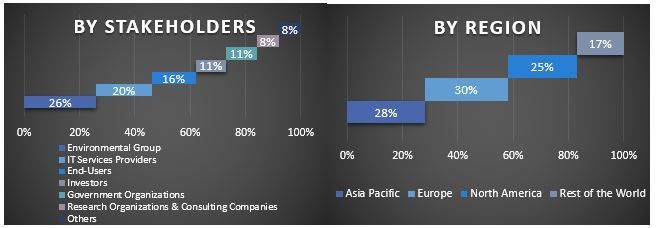
Инженерия рынка
Метод триангуляции данных был использован для завершения общей оценки рынка и получения точных статистических данных для каждого сегмента и подсегмента глобального рынка цифровой трансформации в энергетике. Данные были разделены на несколько сегментов и подсегментов после изучения различных параметров и тенденций в технологиях, приложениях и регионах глобального рынка цифровой трансформации в энергетике.
Основная цель исследования мирового рынка цифровой трансформации в энергетике
В исследовании были определены текущие и будущие тенденции мирового рынка цифровой трансформации в энергетике. Инвесторы могут получить стратегическое понимание, чтобы основывать свое решение об инвестициях на качественном и количественном анализе, проведенном в исследовании. Текущие и будущие рыночные тенденции определили общую привлекательность рынка на региональном уровне, предоставив участникам отрасли платформу для использования неиспользованного рынка, чтобы получить выгоду от преимущества первого хода. Другие количественные цели исследований включают:
- Анализ текущего и прогнозируемого размера рынка цифровой трансформации в энергетике в стоимостном выражении (USD). Также анализ текущего и прогнозируемого размера рынка различных сегментов и подсегментов.
- Сегменты в исследовании включают области технологий, приложений и регионов.
- Определение и анализ нормативно-правовой базы для цифровой трансформации в энергетике
- Анализ цепочки создания стоимости с учетом присутствия различных посредников, а также анализ поведения клиентов и конкурентов отрасли.
- Анализ текущего и прогнозируемого размера рынка цифровой трансформации в энергетике для основного региона.
- Основные страны регионов, изученных в отчете, включают Азиатско-Тихоокеанский регион, Европу, Северную Америку и Остальной мир
- Профили компаний рынка цифровой трансформации в энергетике и стратегии роста, принятые игроками рынка для устойчивого развития на быстрорастущем рынке.
- Углубленный анализ промышленности на региональном уровне
Часто задаваемые вопросы Часто задаваемые вопросы
Вопрос 1: Каков текущий размер и потенциал роста мирового рынка цифровой трансформации в энергетике?
Вопрос 2: Какие факторы обусловливают рост мирового рынка цифровой трансформации в энергетике?
Вопрос 3: Какой сегмент занимает наибольшую долю мирового рынка цифровой трансформации в энергетике по технологиям?
Вопрос 4: Какие новые технологии и тенденции наблюдаются на мировом рынке цифровой трансформации в энергетике?
Вопрос 5: Какой регион будет доминировать на мировом рынке цифровой трансформации в энергетике?
Связанные Отчеты
Клиенты, купившие этот товар, также купили




